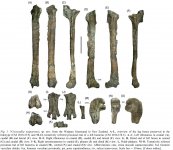Fred Ruhe
Well-known member

Gerald Mayr, Vanesa L. De Pietri, Leigh Love, Al A. Mannering & Richard Paul Scofield, 2019
Leg bones of a new penguin species from the Waipara Greensand add to the diversity of very large-sized Sphenisciformes in the Paleocene of New Zealand
Alcheringa: An Australasian Journal of Palaeontology, Latest Articles
Abstract: https://www.tandfonline.com/doi/full/10.1080/03115518.2019.1641619
We describe a new large-sized species of the Sphenisciformes (penguins) from Paleocene strata of the Waipara Greensand in New Zealand. ?Crossvallia waiparensis, sp. nov. is represented by leg bones of a single individual as well as two tentatively referred proximal humeri and resembles Crossvallia unienwillia from the late Paleocene of Antarctica in size and morphology. The new species is the fifth published species of stem group Sphenisciformes from the Waipara Greensand and the fourth one, which has been formally named. It is distinguished from a recently reported tarsometatarsus of an unnamed large-sized penguin species from the Waipara Greensand and is the oldest well-represented giant penguin. ?C. waiparensis approaches the size of the Eocene taxa Anthropornis and Palaeeudyptes and provides further evidence that penguins attained a very large size early in their evolutionary history.
No free pdf but I found the paper at http://sci-hub.tw/https://www.tandfonline.com/doi/full/10.1080/03115518.2019.1641619
Enjoy
Fred
Leg bones of a new penguin species from the Waipara Greensand add to the diversity of very large-sized Sphenisciformes in the Paleocene of New Zealand
Alcheringa: An Australasian Journal of Palaeontology, Latest Articles
Abstract: https://www.tandfonline.com/doi/full/10.1080/03115518.2019.1641619
We describe a new large-sized species of the Sphenisciformes (penguins) from Paleocene strata of the Waipara Greensand in New Zealand. ?Crossvallia waiparensis, sp. nov. is represented by leg bones of a single individual as well as two tentatively referred proximal humeri and resembles Crossvallia unienwillia from the late Paleocene of Antarctica in size and morphology. The new species is the fifth published species of stem group Sphenisciformes from the Waipara Greensand and the fourth one, which has been formally named. It is distinguished from a recently reported tarsometatarsus of an unnamed large-sized penguin species from the Waipara Greensand and is the oldest well-represented giant penguin. ?C. waiparensis approaches the size of the Eocene taxa Anthropornis and Palaeeudyptes and provides further evidence that penguins attained a very large size early in their evolutionary history.
No free pdf but I found the paper at http://sci-hub.tw/https://www.tandfonline.com/doi/full/10.1080/03115518.2019.1641619
Enjoy
Fred




